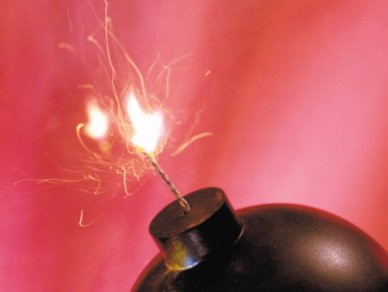Communication through chemistry: “Fuses” convey information for hours
We currently transmit information electronically; in the future we will most likely use photons. However, these are not the only alternatives. Information can also be transmitted by means of chemical reactions. George M. Whitesides and his colleagues at Harvard University in Cambridge (Massachusetts, USA) have now developed a concept that allows transmission of alphanumeric information in the form of light pulses with no electricity: the “infofuse”. As the researchers report in the journal Angewandte Chemie, it may be possible to use this principle to develop systems that function under conditions in which electronics or batteries do not work.
Salt Dots
The researchers previously developed an infofuse made of nitrocellulose strips. The strips were covered with patterns of dots made of salts of the elements lithium, rubidium, and cesium. When the strip is ignited, the flame travels forward and reaches the dots one after the other. The heat causes the elements to emit light at characteristic wavelengths. The dots may contain combinations of three different salts, resulting in seven possible combinations. A combination of two dots thus allows for 7×7 = 49 different signals.
The problem was that the flame tended to go out. This can be avoided by using a different material as substrate that does not conduct heat away as efficiently, such as fiberglass. Alternatively, the strips can be placed over a “trench” or crimped, so that they no longer lie flat on the surface. This allows for less heat transfer to the substrate.
Dual Speed Arrangement
Another problem with the older system was that the flame front progressed far too quickly, allowing for only short transmission times. Nitrocellulose strips burn at a rate of several centimeters a second. Says Whitesides, “a fuse length of 2.6 km would be required to transmit for 24 hours.” The solution was a dual speed arrangement. Branches of the fast-burning infofuse are attached to a slow-burning central fuse. The distance between branches can be varied as needed, and the flame front progresses at only 1 to 2 m per second. This allows information to be repeated several times or different information to be transmitted periodically.
A color camera or fiber optic cable coupled to a spectrometer could receive the signal over a distance of 30 m in daylight. “We hope that it will be possible to develop a light, portable, non-electric system of information transmission that can be integrated into modern information technology,” says Whitesides. “For example, it could be used to gather and transmit environmental data or to send messages by emergency services.”
- Long-Duration Transmission of Information with Infofuses
C. Kim, S. W. Thomas III, G. M. Whitesides,
Angew. Chem. Int. Ed. 2010, 49 (27), 4571–4575.
DOI: 10.1002/anie.201001582




